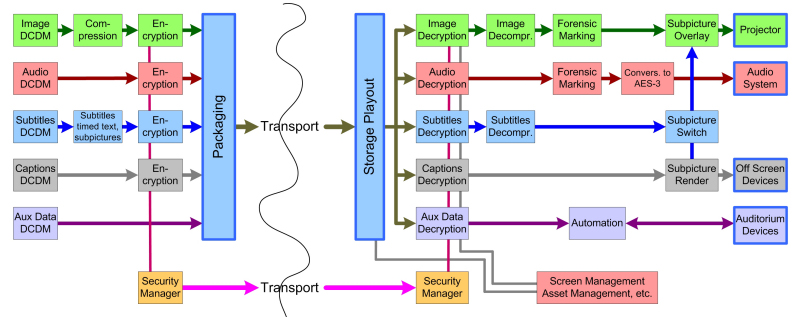
distribution system for digital cinema
Digital cinema standards are defined by the Digital Cinema Initiatives, LLC (DCI), a joint venture of venture of Disney, Fox, Paramount, Sony Pictures Entertainment, Universal and Warner Bros. Studios. It was created in 2002. The DCI establishes specifications for digital cinema to ensure a high level of technical performance, reliability and quality control for digital cinema in an open architecture.
The picture format for digital cinema is specified as the image compression format JPEG 2000 (defined in standard ISO/IEC 15444-1). JPEG 2000 was created by the Joint Photographic Experts Group committee in 2000 based on the original JPG standard. The file name extensions are .jp2, .j2k, .jpf, .jpx, .jpm, .mj2. JPEG 2000 files (.jpx files) can also carry metadata in XML form. The metadata is saved in a so-called XML box of the file.
The image resolution is specified by the horizontal pixel count in opposition to the video format specification based on the number of vertical lines (720, 1080). The cinema resolutions are differentiated by the horizontal pixel count of 1024 pixels, called as "1K".
An image with a horizontal pixel count of 2048 is called "2K" and with a horizontal pixel count of 4096 is called "4K". Because of the different geometrical cinema formats (2.35:1 etc.), the vertical resolution varies with the aspect ratio. A 2048 x 1152 pixel image in the format 16:9 is a "2K" image as is the 2048 x 872 pixel image in the format 2.35:1.
The Audio format for digital cinema is WAV (Broadcast Wave), 24 bits, 48 kHz or 96 kHz sampling.
The digital content is produced in a so-called 'trusted environment'. From there it is distributed by hard drives, optical disks or satellite to certified movie theatres. Within the theatre the content is stored on a Digital Cinema Server.
Only certified cinema projectors can be used to make the content actually visible to the audience after decoding.

A digital cinema projection systems consists of three primary hardware components: the storage device holding the content, the media block to decrypt, decode and format the content during playback and the digital cinema projector that projects the image on screen. Mostly the storage and the media block are located in a server and are physically distinct from the projector. The signal will be transmitted between the server and projector by dual link HD-SDI cables.
Digital Source Master (DSM)
It is created in the post-production process as source for the Digital Cinema Distribution Master (DCDM) or to be converted to a film duplication master, a home video master or a master for archive reasons.
Composition
All parts that can belong to a complete package (any content that would have similar requirements, feature, trailer, advertisement or logo), the "essence" and all metadata required for a presentation.
Digital Cinema Distribution Master (DCDM)
The DCDM is built from the Digital Source Master (DSM). The purpose of the DCDM is the exchange of image, audio and subtitles to encoding systems and to the Digital Cinema playback system. It is created in the Digital Cinema post-production process (which is different from the feature post-production process) and is a collection of files. The DCDM is then compressed, encrypted and packaged for distribution as the Digital Cinema Package.
Digital Cinema Package (DCP)
The compressed, encrypted and packaged DCDM is called the Digital Cinema Package (DCP). The DCP is sent to the movie theatre there it will be un-packaged, decrypted and decompressed to re-create the DCDM, now called DCDM*. The DCDM* image is the exact copy of the DCDM image.

The companies Dolby, MikroM and XDC have formed the Digital Cinema Alliance to establish open interface standards and common interface specifications between digital cinema servers and integrated media block products.
The SMPTE standard ST 0431-1-2006 defines luminance level, chromaticity and uniformity of the cinema screen, it specifies absolute luminance level, white point chromaticity, and luminance uniformity of the reflected screen light. Screens must be standardized in the same way as the entire video signal path to ensure that tone scale and contrast in the projected image corresponds to the results during the mastering process.
Digital cinema projectors are regularly set for a frame rate of 24 frames per second (fsp). By definition cinema projectors don't support higher frame rates at high-definition resolutions as possible on high-definition TVs. Now higher frame rates are possible in Digital Cinema too. Many projectors can be updated (firmware) to display for instance 60 frames per second in 2D and 3D and 48 frames per second in "Double Flash 3D".
The effect of higher frame rates is a much smoother and sharper image especially with fast moving content. The problem with higher frame rates is the data traffic between the server, the media block, and the projector itself. The higher the frame rate the higher the traffic over the cable connection between both.
A new architecture is the integrated media block that is integrated inside the projector to avoid any cable connection between media block and projection engine. The higher frame rate content passes directly to the projector.